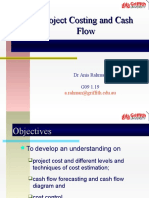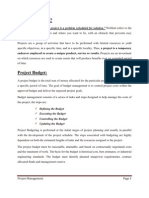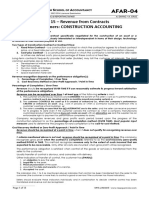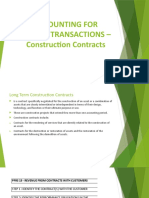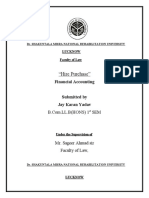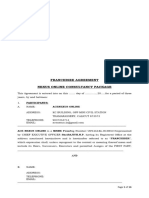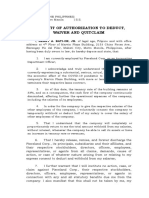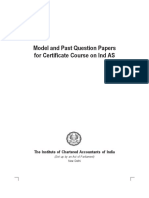Investment Appraisal: Important Formulas For The PMP® Exam
Investment Appraisal: Important Formulas For The PMP® Exam
Uploaded by
log2manuCopyright:
Available Formats
Investment Appraisal: Important Formulas For The PMP® Exam
Investment Appraisal: Important Formulas For The PMP® Exam
Uploaded by
log2manuOriginal Title
Copyright
Available Formats
Share this document
Did you find this document useful?
Is this content inappropriate?
Copyright:
Available Formats
Investment Appraisal: Important Formulas For The PMP® Exam
Investment Appraisal: Important Formulas For The PMP® Exam
Uploaded by
log2manuCopyright:
Available Formats
Important Formulas for the PMP exam
Investment Appraisal
Payback Period: Payback Period is achieved when the cumulative cash flow becomes equal to the initial investment. Shorter the payback period, better the project. Net Present Value (NPV) NPV = Initial Investment less cumulative PV of all cash flows for n years n Present Value (PV) = FV / (1 + r) r = discount rate n = valuation period in years FV = Future Value A higher NPV is better. Higher the Discount rate, lower the NPV IRR The discount rate at which NPV is zero Benefit Cost Ratio (BCR) BCR < 1 : reject project BCR > 1: accept the project PERT / SD. (PERT can be used for both Time and Cost dimensions) Formula PERT Duration Activity Variance 2 Activity Standard Deviation SD () PERT (BETA Distribution) O + 4(ML) + P 6 {(P O) /6}2 (Standard Deviation squared) (P O) / 6 Triangular Distribution O + ML + P 3 ((P - O)2 + (ML O)*(ML P))/18
Note: Default for PERT calculations is the BETA distribution formulas Confidence levels (Mean n ) 1 Sigma () 2 3 6
68.26% 95.46% 99.73% 99.999%
To find range of estimate for Individual Activities: PERT duration for the activity SD To find range of estimate at Project Level: Step 1: Add all the PERT durations in the critical path. Step 2: Calculate the Variance for each activity in the critical path. Step 3: Add all the Variances. Step 4: Take square root of the sum of all the Variances which gives the SD. Step 5: Project duration range estimate is total project PERT duration (step 1) SD (step 4). Page 1
Earned Value Formulas SV = EV-PV CV = EV-AC SPI = EV/PV CPI = EV/AC Forecasting EAC EAC = BAC/ CPI cumulative EAC = AC + (BAC-EV) CPI new EAC = AC + (BAC-EV) EAC = AC + ETC new TCPI = BAC-EV BAC-AC
- To forecast EAC when ETC will be performed at the cumulative CPI - To forecast EAC when a different / assumed CPI will be used for ETC - To forecast EAC when ETC will be performed as per the original budget (BAC) - To forecast EAC when totally new estimates are developed for ETC
(Remaining work) (Remaining Budget)
Earned Value Acronyms & formulas Acronym PV EV AC BAC SV Term Planned Value Earned Value Actual Cost Budget At Completion Schedule Variance Definition Planned cost or value of the work to be done till this point in time. The value of the work accomplished till this point in time. Cost is as per the original budget. The costs actually incurred to complete the work till this point in time. The total planned value or budget for completing the entire project. Difference between the scheduled completion and actual completion of an activity or group of activities. Negative SV - is behind schedule. Positive SV- is ahead of schedule. Difference between the budgeted cost of completing an activity/group of activities and the actual budget spent for it. Negative CV: is over budget. Positive CV - is under budget. The measure of efficiency in managing the projects schedule. SPI > 1 is good (ahead of schedule) = 1 on target < 1 poor (behind schedule) The measure of efficiency in managing the projects budget. CPI > 1 is good (under budget) = 1 is on target <1 is poor (over budget) Prediction of what project will cost when completed. EAC is calculated using different formulas for different possible conditions. How much more we expect project to cost from this point in time. How much under budget or over budget we expect the project to be once it is completed. The remaining cost performance needed in project to stay within the planned budget (BAC).
CV
Cost Variance
SPI
Schedule Performance Index
CPI
Cost Performance Index
EAC ETC VAC TCPI
Estimate At Completion Estimate To Complete Variance At Completion To Complete Performance Index
Page 2
Some Contractual Terms Arbitration Breach of contract Contract Condition Design specifications Force Majeure Settling a dispute out of court using an independent third party. The arbitrator must be agreed upon and accepted by both parties. Violating or breaking of a legal obligation. Is a serious condition. Buyer should always issue letter to contractor notifying the breach. A written or oral agreement made by one party to another that has legal obligations on both parties. A term of fundamental importance in the contract. Breach of this condition can cause the contract to be terminated. A detailed description of the physical characteristics describing and specifying what is to be done. Used in contracts to free both parties from liabilities arising from events beyond their control e. g. strikes, war, floods, earthquake etc. Common response is for buyer to extend the time. Transparency and fair dealing between all parties. Violation of a legally recognized right. A payment or compensation as protection against any future loss. It is an obligation made by one party to reimburse another party for losses that have occurred or that may occur in future. Reasonable damages to be paid by the contractor to the owner due to failure to complete the specified work as per the contract terms. Not acting in a reasonably accepted manner. The contractor is not allowed to work for a competitor for a given time. A restriction on the contractor from disclosing some proprietary knowledge gained in doing the work. An agreement made in financial terms to be paid by the contractor for not performing as per the contract terms. The measurable capabilities that the product should achieve in terms of operational characteristics. They must be met by the contractor. A mutual relationship that exists between a buyer and seller. The contract cannot give rights or impose obligation on any person / party / sub-contractor except the parties that have signed the contract. A process used to determine if a contractor has the minimum qualifications to bid. The seller is the only available source for the procurement. Giving up of a legal right or privilege voluntarily A written, verbal or implied promise assuring that a specified provision in the contract is true. Provides protection to the buyer against breakdowns and major repairs.
Good faith Infringement Indemnity
Liquidation damages Negligence Non-compete clause Non-disclosure / confidentiality clause Penalty clause Performance specifications Privity of contract
Screening system Sole source Waiver Warranty
Page 3
Types of Estimates Rough Order of Magnitude (ROM) estimate - Initiating phase: +/- 50% Budget Estimate - early Planning phase: -15% to +25% Definitive or detailed estimate - Planning phase: +10% to -10% Communication channels Communication channels between people = {n(n-1) } / 2 n = total number of persons Procurement Fixed Price Incentive Fee (FPIF) contract Point of Total Assumption (PTA): The point at which additional cost overruns have to be fully borne by contractor. Costs above PTA are assumed to be the result of mismanagement. PTA is only applicable in FPIF contracts. PTA = { (Ceiling price - Target price) /Buyers share ratio} + Target cost Price: The amount charged to buyer by seller (contractor) Target cost: Expected cost for doing the work at time of signing the contract Target fee: Sellers planned profit margin or fee for doing the work. Will be increased / decreased using the Share ration based on performance Target Price: Target cost + target fee Share ratio: Ratio by which Buyer/Seller will share cost savings and cost overruns Ceiling Price: The maximum amount the buyer will pay for the contract irrespective of the costs. Actual Cost: Costs that actually incurred at end of contract
Cost Plus Incentive Fee (CPIF) contract: CPIF includes all of the above terms except Ceiling Price and Point of Total Assumption (PTA) . Instead CPIF has a Minimum fee and a Maximum fee: Minimum Fee: Minimum assured fee buyer will pay to contractor Maximum Fee: Maximum fee that buyer will pay to contractor
Quality the degree to which a set of inherent characteristics fulfils (project) requirements Quality Tools Pareto Chart - 80/20 rule. Is a histogram ranking no. of defects in order of frequency or importance - 80% quality problems due to 20% causes
Page 4
Control chart - Used to decide whether the product or service is in control or out of control - Identifies special or assignable causes - Has a mean or center line, an upper control limit (UCL) and a lower control limit (LCL) - Does not show causes for deviation or provide solutions Cause-and-Effect diagram (Fishbone or Ishikawa diagram) - Graphical technique that helps team to group ideas and identify the causes of a problem - Breaks down problem for analysis - Shows how different variables may be linked to the effect (problem) Sampling Attribute sampling: checks that the result either conforms or does not conform pass or fail Variable sampling: checks the degree to which the result conforms acceptable within a tolerance level
Risk Response strategies
Response Strategy Avoid
Risk Threats i.e. Negative risks
Effect of Response Remove root cause. Project management plan changed to completely remove threat e.g. extend schedule, reduce scope by removing work package or activity, remove a team member, etc. Third party made financially responsible for negative impact and ownership of response. e.g. insurance, contracts, warranties etc. Transfer does not eliminate the risk. Probability or Impact or both to acceptable threshold limits e.g. make a prototype, improve skills through training No change made in the project management plan to deal with risk or unable to select suitable response. Passive acceptance no action taken Active acceptance - Contingency reserve commonly kept time, money or resources to deal with the risk Change plans to remove uncertainty to ensure the opportunity occurs Allocate some or all ownership of opportunity to third party as they are better equipped e.g. joint ventures, teams, partnerships Increase positive Impact or Probability or both of opportunity e.g. add more resources to finish early Accept the risk if it occurs. Not actively pursued
Transfer
Mitigate
Accept
Opportunities i.e. Positive risks
Exploit
Share
Enhance Accept
Page 5
You might also like
- Intermediate Accounting 1: a QuickStudy Digital Reference GuideFrom EverandIntermediate Accounting 1: a QuickStudy Digital Reference GuideNo ratings yet
- Lecture 6 - Project Costing and Cash FlowDocument45 pagesLecture 6 - Project Costing and Cash FlowLewis100% (2)
- Accounting For Construction ContractsDocument8 pagesAccounting For Construction ContractsSantu DuttaNo ratings yet
- Pueblo County Personnel Manual 2016Document82 pagesPueblo County Personnel Manual 2016Colorado Ethics Watch100% (1)
- Fa Standard Player Intermediary Representation ContractDocument3 pagesFa Standard Player Intermediary Representation ContractAdzNo ratings yet
- Definiciones en Inglés para Gerencia de ProyectosDocument9 pagesDefiniciones en Inglés para Gerencia de ProyectosJosé Vallejo HerreraNo ratings yet
- AFAR-05: PFRS 15 - Revenue From Contracts With Customers: Construction AccountingDocument10 pagesAFAR-05: PFRS 15 - Revenue From Contracts With Customers: Construction AccountingManuNo ratings yet
- Accounting Standard 5-8Document36 pagesAccounting Standard 5-8Aseem1No ratings yet
- Five Project Management Performance Metrics Key To Successful Project ExecutionDocument7 pagesFive Project Management Performance Metrics Key To Successful Project ExecutionNaokhaiz AfaquiNo ratings yet
- Objectives of Cost Analysis ControlDocument19 pagesObjectives of Cost Analysis Controlprecious omokhaiyeNo ratings yet
- Project Management SHAWNDocument35 pagesProject Management SHAWNdzedziphillyNo ratings yet
- MODULE 4 - Construction Cost Estimate: Ce 142-T Project Management & Construction MethodsDocument42 pagesMODULE 4 - Construction Cost Estimate: Ce 142-T Project Management & Construction MethodsNiño EvangelioNo ratings yet
- Chapter 3 Pfrs 15 Construction ContractDocument11 pagesChapter 3 Pfrs 15 Construction Contractshylabaguio15No ratings yet
- Topic - 7 - Project Cash Flow PDFDocument32 pagesTopic - 7 - Project Cash Flow PDFnoor basha100% (2)
- Lecture 4Document43 pagesLecture 4decentdawoodNo ratings yet
- Types of ContractsDocument27 pagesTypes of ContractsWaelBouNo ratings yet
- AFAR 04 Construction AccountingDocument13 pagesAFAR 04 Construction Accountingmysweet surrenderNo ratings yet
- Notes LTCCDocument2 pagesNotes LTCCMila Casandra CastañedaNo ratings yet
- Module 6Document17 pagesModule 6hh27qp9cg6No ratings yet
- unit-III-Capital BudgetingDocument4 pagesunit-III-Capital Budgetingpandith9021No ratings yet
- Construction Contracts: Measuring Revenues, Expenses and COGSDocument10 pagesConstruction Contracts: Measuring Revenues, Expenses and COGSNancy LHINo ratings yet
- Brain DumpsDocument25 pagesBrain DumpsShady Shaker100% (1)
- Phase III: Execution Phase IV: Monitoring and Control: Earned Value AnalysisDocument51 pagesPhase III: Execution Phase IV: Monitoring and Control: Earned Value AnalysisPavan ChallaNo ratings yet
- Unit-3 Project Monitoring and ControlDocument12 pagesUnit-3 Project Monitoring and ControlAjay KumarNo ratings yet
- Explain Gantt Chart. 3 MARKSDocument8 pagesExplain Gantt Chart. 3 MARKSHeet PatelNo ratings yet
- Project Cost ControlDocument15 pagesProject Cost ControlMuhammad Sageer100% (3)
- Practice Note: Remunerating Professional Service ProvidersDocument8 pagesPractice Note: Remunerating Professional Service ProvidersRonnieNdozirehoNo ratings yet
- Engineers Economics TermsDocument4 pagesEngineers Economics TermsMark AlderiteNo ratings yet
- Ahmad NadeemDocument54 pagesAhmad NadeemgibsNo ratings yet
- Explain The PreDocument5 pagesExplain The PreVistash BuharyNo ratings yet
- AFAR-04 (Construction Accounting)Document16 pagesAFAR-04 (Construction Accounting)Nathalie Shien Dagaraga100% (1)
- Project TopicDocument28 pagesProject TopicAtifa TanvirNo ratings yet
- AFAR-04 (Construction Accounting)Document13 pagesAFAR-04 (Construction Accounting)Project ACADSNo ratings yet
- 20.03.21 - Ce181 Lecture 2 - Estimate GuidelinesDocument42 pages20.03.21 - Ce181 Lecture 2 - Estimate GuidelinesYves Harvey Garcia Escarez100% (1)
- Financial Economic Assessment of ProjectDocument57 pagesFinancial Economic Assessment of ProjectLiberatus Mpeta100% (1)
- AFAR-04 (Construction Accounting)Document13 pagesAFAR-04 (Construction Accounting)Ruth RodriguezNo ratings yet
- CompTIA Project Master Cheat SheetDocument25 pagesCompTIA Project Master Cheat SheetWayne WayneNo ratings yet
- WGU - c176 - Terms and DefinitionsDocument15 pagesWGU - c176 - Terms and DefinitionsdrthtaterNo ratings yet
- Chap 9 Notes To Accompany The PP TransparenciesDocument8 pagesChap 9 Notes To Accompany The PP TransparenciesChantal AouadNo ratings yet
- Project CharterDocument7 pagesProject CharterNishant GambhirNo ratings yet
- Measures of Project Worth PresentationDocument9 pagesMeasures of Project Worth PresentationjudkodjoNo ratings yet
- AFAR-04 (Construction Accounting)Document13 pagesAFAR-04 (Construction Accounting)Maricris Alilin100% (1)
- Project Cost Management: Dhammika T. GamageDocument45 pagesProject Cost Management: Dhammika T. GamageNiranjan AbeyrathnaNo ratings yet
- ACCOUNTING FOR SPECIAL TRANSACTIONS - Construction ContractsDocument29 pagesACCOUNTING FOR SPECIAL TRANSACTIONS - Construction ContractsDewdrop Mae RafananNo ratings yet
- Cost Estimation and Analysis1Document49 pagesCost Estimation and Analysis19819143966No ratings yet
- Cost Monitoring and ControlDocument50 pagesCost Monitoring and ControlTrevor T ParazivaNo ratings yet
- Project BudgetingDocument24 pagesProject BudgetingVladimerNo ratings yet
- Initiating Step of ADocument7 pagesInitiating Step of ANayan RathodNo ratings yet
- Ms 52Document17 pagesMs 52Rishi BawejaNo ratings yet
- Cost Estimating & BudgetingDocument36 pagesCost Estimating & BudgetingMohakNo ratings yet
- Life Cycle Costing TheoryDocument6 pagesLife Cycle Costing TheoryVikas SinghNo ratings yet
- System Analysis and DesignDocument11 pagesSystem Analysis and DesignCristy Balubayan NazarenoNo ratings yet
- Combined Heating, Cooling & Power HandbookDocument18 pagesCombined Heating, Cooling & Power HandbookFREDIELABRADORNo ratings yet
- PMP V3Document4 pagesPMP V3giftsthrinayNo ratings yet
- Lecture 6 PDFDocument19 pagesLecture 6 PDFMarco Vincenti ZakhiaNo ratings yet
- Session 11 Cost ManagaamentDocument23 pagesSession 11 Cost ManagaamentAbdul WahidNo ratings yet
- Appendix - A Cost Estimation Methodology FinalDocument4 pagesAppendix - A Cost Estimation Methodology FinalEmdad YusufNo ratings yet
- Submitting a Winning Bid: Guide to Making Construction Bidding with ExamplesFrom EverandSubmitting a Winning Bid: Guide to Making Construction Bidding with ExamplesNo ratings yet
- Cost Estimating Basics: Charles P. Woodward, PE CCE, and Mark T. Chen, PE CCEDocument8 pagesCost Estimating Basics: Charles P. Woodward, PE CCE, and Mark T. Chen, PE CCEkamlNo ratings yet
- AGILE V2 Buisness Case TemplateDocument7 pagesAGILE V2 Buisness Case TemplateAndrew ClarkNo ratings yet
- Low Ball Bid Awarding CriteriaDocument8 pagesLow Ball Bid Awarding CriteriaRASHID HUSSAINNo ratings yet
- Mega Project Assurance: Volume One - The Terminological DictionaryFrom EverandMega Project Assurance: Volume One - The Terminological DictionaryNo ratings yet
- Kasambahay FormsDocument6 pagesKasambahay FormsRenAraf100% (1)
- Repair Maintenance Labor FinalDocument21 pagesRepair Maintenance Labor FinalJaneDandanNo ratings yet
- Orca Share Media1577676507201Document4 pagesOrca Share Media1577676507201Jayr BVNo ratings yet
- DAMAGES (Torts) CasesDocument65 pagesDAMAGES (Torts) CasesMaanNo ratings yet
- 7.1.1 Warehouse Contract Example 1Document5 pages7.1.1 Warehouse Contract Example 1Pocahantas AquaNo ratings yet
- 3rd QuizDocument2 pages3rd QuizRobert MantoNo ratings yet
- G.R. No. 161318 November 25, 2009 Julie Nabus, Michelle Nabus and Betty Tolero, Petitioners, JOAQUIN PACSON and JULIA PACSON, RespondentsDocument35 pagesG.R. No. 161318 November 25, 2009 Julie Nabus, Michelle Nabus and Betty Tolero, Petitioners, JOAQUIN PACSON and JULIA PACSON, RespondentsMichael Ang SauzaNo ratings yet
- RIBXG Series: Ac Current SwitchesDocument2 pagesRIBXG Series: Ac Current SwitchesJorge Garcia BarronNo ratings yet
- Construction AccountingDocument12 pagesConstruction AccountingtezgajNo ratings yet
- Pelayo, Christopher Philip M. LLB Iii - C Law On InsuranceDocument3 pagesPelayo, Christopher Philip M. LLB Iii - C Law On InsuranceChristopher PhilipNo ratings yet
- Land Titles Case DigestsDocument4 pagesLand Titles Case DigestsNino Kim AyubanNo ratings yet
- 7 - Political and Legal Environment Case StudyDocument3 pages7 - Political and Legal Environment Case StudyChantelle ONo ratings yet
- Guide To Vietnamese Labor Law For The Garment Industry: (Fifth Edition, 2017)Document85 pagesGuide To Vietnamese Labor Law For The Garment Industry: (Fifth Edition, 2017)LeNamYenNo ratings yet
- "Hire Purchase": Financial Accounting Submitted by Jay Karan YadavDocument10 pages"Hire Purchase": Financial Accounting Submitted by Jay Karan YadavDivyansh SinghNo ratings yet
- Republic v. Sandiganbayan & Marcos (2003)Document3 pagesRepublic v. Sandiganbayan & Marcos (2003)Andre Philippe RamosNo ratings yet
- Case Digest - Week 3 - Mutuum, Cases 1,2,3,4,5,6,7,8,10Document9 pagesCase Digest - Week 3 - Mutuum, Cases 1,2,3,4,5,6,7,8,10Anonymous b4ycWuoIcNo ratings yet
- Expenditure Verification ReportDocument21 pagesExpenditure Verification ReportAnonymous XSixrIu100% (1)
- EPC Vs EPCMDocument4 pagesEPC Vs EPCMNemanja KlisaraNo ratings yet
- Commission Details - 1000008294Document2 pagesCommission Details - 1000008294SUNDAR PNo ratings yet
- Franchise Agreement - Nexus Suvidha + CSPDocument16 pagesFranchise Agreement - Nexus Suvidha + CSPrbgrouprsbNo ratings yet
- AFFIDAVIT OF Authorization To DeductDocument2 pagesAFFIDAVIT OF Authorization To DeductALMEDA INC100% (1)
- Void Or: Inexistent ContractsDocument20 pagesVoid Or: Inexistent ContractsRichard LamagnaNo ratings yet
- CD Legal Ethics 3Document52 pagesCD Legal Ethics 3Yasser AureadaNo ratings yet
- Model and Past Question PapersDocument537 pagesModel and Past Question PapersSumit Anand0% (1)
- Accounting Theory and Policy - (Final Paper) - International Islamic University MalaysiaDocument6 pagesAccounting Theory and Policy - (Final Paper) - International Islamic University MalaysiaMaas Riyaz Malik100% (1)
- Case Digest - Labor RelationDocument4 pagesCase Digest - Labor RelationJanine Prelle DacanayNo ratings yet
- Saln ManualDocument29 pagesSaln ManualRojan Alexei GranadoNo ratings yet
- Eo 150 RRDDocument35 pagesEo 150 RRD'Thon SysadminNo ratings yet

